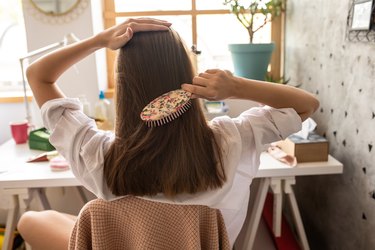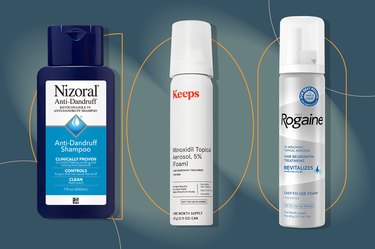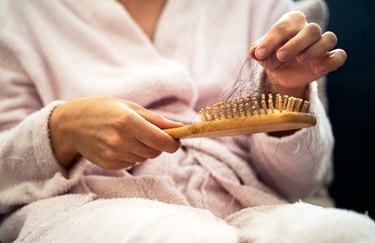
Look back at a picture from 10, 20 or more years ago, and there's a good chance the hair on your head then isn't quite the same as what's there now. Truth is, your locks don't just look different — you've got an entirely new head of hair.
This didn't happen overnight, of course. But if you've ever heard that old wives' tale of your hair changing every seven years, well, there's some truth to it.
Video of the Day
Video of the Day
Individual hair strands really do sprout, grow and fall out in a multi-year cycle. "Each hair is a living entity with an average duration of two to six years," says board-certified dermatologist Jeffrey Hsu, MD, co-founder and co-director of Oak Dermatology in Chicago. "In humans, the cycle isn't synchronized, meaning that each hair is independent from the others."
Over time, that adds up to a new head of hair. And thanks to normal age-related changes, the hairs you're growing now may look different than the ones that came before them.
How Hair Grows
Human hair grows in a three-phase cycle. There are about 100,000 hairs on a human head, and each goes through a period of growth and rest before the hair detaches from the scalp and falls out, explains board-certified dermatologist Rohit Kakar, MD, owner and director of Orchard Lake Dermatology & Cosmetics in Orchard Lake, Michigan.
Normal hair loss is between 50 and 100 hairs a day, many of which are shed while you wash, comb or brush.
After a hair falls out, the follicle from which it stemmed stays dormant for about a year, according to the National Library of Medicine. Once the follicle is well-rested, a new strand forms and starts growing once again.
Tip
If it seems like you're losing considerably more than 100 strands of hair per day, or your hair seems to come out very easily (like when you run your fingers through it), it's a good idea to let your doctor know. Sometimes hair loss could be related to an underlying medical problem or a medication you're taking.
So Every 7 Years, Do You Have a New Head of Hair?
Well, yes and no. It's true that most of the hairs on your head today weren't there seven or more years ago. But because individual hairs fall out and regrow at different rates, not all of your current hairs are new, Dr. Hsu explains.
In other words, some hairs could be sproutlings that are just a few months or a year old, while others could be relative old-timers that have been hanging on for several years. And a small percentage of follicles — between 1 and 3 percent — are dormant, without any hairs growing at all.
As for which hairs fall out when? Ultimately, your pattern of hair loss and regrowth is pretty random. That's a good thing, because it means you're less likely to develop hair loss in one concentrated area, where it might be more noticeable.
"Different hair follicles are in different phases of the hair cycle because there is no synchronization, which allows you to have constant density of hair," Dr. Kakar says.
One other thing? Seven years is the upper lifespan limit for a human hair, but that doesn't necessarily mean all of your hairs will make it for that long. Our hair growth-and-loss cycles tend to get shorter with age, and people assigned female at birth generally have longer growth phases than those assigned male at birth.
Hormonal shifts, illness and damage to a hair follicle, on the other hand, can all cause a hair to fall out sooner. So can chronic stress, Dr. Hsu says.
If it feels like your hair isn't quite the same today as it was when you were younger, there's a reason for that. A hair that grows back in place of an old one that fell out might have different features than its predecessor, says Dr. Hsu. Over time, that can cause your mane as a whole to change.
As you age, you may notice that your hair starts to become:
- Thinner: As the growth phase of hair shortens, the diameter of each individual strand starts to decrease. As an increasing number of these thinner hairs grow in, your hair may not look and feel as thick as it used to, Dr. Kakar explains.
- Drier or rougher: The scalp produces less sebum, or natural oil, as we get older. "This results in less smoothness, softness and shine of the hair with age," says Dr. Kakar.
- Grayer: You knew this one was coming. As the years pass, more and more hair follicles lose the pigment-producing cells that give our strands color, causing the new hairs that grow back to be gray.
Was this article helpful?
150 Characters Max
0/150
Thank you for sharing!
Thank you for your feedback!
Is this an emergency? If you are experiencing serious medical symptoms, please see the National Library of Medicine’s list of signs you need emergency medical attention or call 911.


